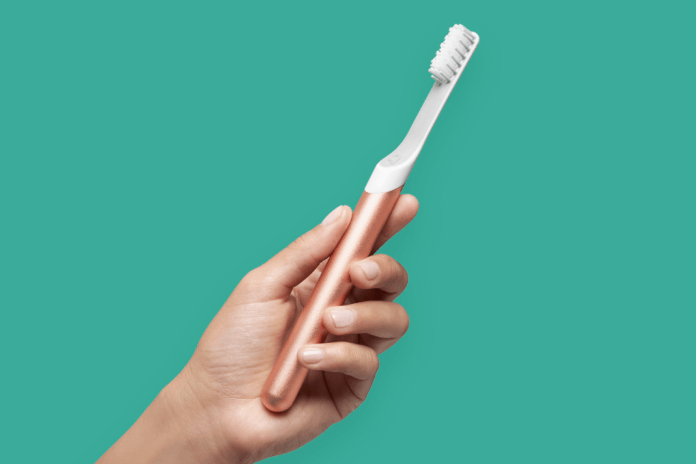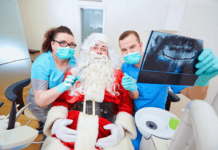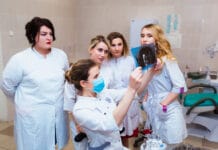As a hygienist, I’m usually skeptical of new products that come on the market until I can actually research and try them out myself. Like most hygienists, I’ve had patients who ask me about a new toothbrush or toothpaste and want to get a hygienist’s opinion. Although I try to stay up to date on all things oral care, occasionally a patient will ask about something I haven’t heard of yet.
One example is from one of my regular patients, who came in with noticeably better oral hygiene, and asked me if I knew about quip. When I told her I hadn’t, she proceeded to rave about her new electric brush that delivered brush heads every three months. Little did I know that this brief conversation about an up-and-coming oral care company would inspire me to leave clinical hygiene for a New York City startup.
My journey to work with quip began after my patient asked about it. She had used a manual toothbrush for years and usually presented with moderate, generalized plaque build up and chronic gingivitis. After I recommended she switch to an electric toothbrush to help control plaque, I learned she had previously tried one but couldn’t handle the intense vibrations that “made her head rattle.” Additionally, she was unable to break the habit of brushing back and forth, which is fine with a manual brush but could have caused potential harm with a high powered electric brush.
She eventually reverted back to her trusty manual toothbrush, but that was soon to change. At a later visit, she presented with much healthier gingiva and little to no plaque. I asked if she had been doing anything different with her homecare routine, and that’s when she brought up quip, which she had been using for a few months. She said quip had a two-minute timer that pulsed every 30 seconds so she knew when to switch quadrants and the gentle vibrations encouraged her to brush more gently than she used to.
Then she mentioned something that really struck me as interesting. She had been receiving oral health newsletters from quip with reminders to brush for two minutes twice a day, clean interdentally daily, use a toothpaste with fluoride, and even visit the hygienist and dentist every six months. Not only was she getting those reminders, but she was actually paying attention to them. I feel like a broken record more often than not, as the only person in my patients’ lives who reminds them to do all of these dental hygiene basics, so I was pleasantly surprised that quip was reinforcing my recommendations in between her visits! After seeing her oral health improve, I knew I wanted to learn more about quip.
Before I started working for quip, I researched how quip compared to other brushes in various RDH forums I follow online. It seemed that many hygienists asked, “why should we recommend quip if it’s not as powerful as some of the other toothbrushes on the market?” I was confused because, in my opinion, my patient did such a good job with quip because it was not as high-powered as some other electric brushes. Instead, quip was designed to help patients who were not using, didn’t like or could not afford those electric brushes. Rather than focus on extra power, quip created their brush to be at 15,000 rpm, similar to the “sensitive” mode on some other electric brushes. My patient couldn’t tolerate intense vibrations and struggled to follow the ‘slide-and-glide’ movement, so quip was the perfect combination of an electric brush with a familiar technique, and an affordable price point.
By switching over from a manual brush, my patient was also able to take advantage of quip’s two-minute timer and thirty-second pulses to keep track of how long to brush and help her brush evenly. That got me thinking, how many people were missing those important features by using a manual toothbrush? I worked in private practice in a fairly affluent area, so a majority of my patients owned electric brushes, but I knew this couldn’t be an accurate representation of people across the US. Based on data from a survey done in 2018, I learned that 80% of American’s still used a manual toothbrush!
With most Americans still using a manual brush, there seems to be a big gap in options for electric toothbrushes, as most options are high-intensity and expensive. High-powered electric brushes can be a great option if patients can afford, tolerate, and use them the right way, however many don’t, like the patient I worked with. For her, and many others, quip bridged the gap by presenting a brush that combined the sonic vibrations and guiding features (like a two-minute timer with thirty-second pulses) common with other electrics along with the modified Stillman’s/Bass brushing technique she was used to. I would never try to change a patient’s routine if it was working for them and their oral health, but many out there could really benefit from a simpler, gentler, more affordable option.
After seeing everything quip was doing right, I knew I wanted to be involved with a company that was so dedicated to promoting oral health. I now work for quip full time, helping create ways to promote good habits in a fun and educational way. One of the first things I noticed about quip was the education my patient showed me that day in the operatory, and now I help create that same oral health education, which is shared with over one million people monthly. As hygienists, we are heavily involved in the business side of dentistry when it comes to case acceptance and educating our patients, but we rarely get insight into how the companies whose products we recommend work and operate. The most important aspect of quip and the reason I stand by them as an RDH myself is their mission.
quip is dedicated to making oral care simple and accessible, and they prioritize evidence-based dentistry in all of their products. This is apparent based on how they choose their ingredients, share advice, and design their products. They do not promote unproven ingredients in their products, regardless of how trendy they are or how well they sell. Let’s take charcoal, for example. Charcoal has not been proven to have any effect at all, let alone be safe on enamel long-term. Whether it’s in toothpaste or toothbrush bristles, it’s often marketed as “whitening,” which sends patients the wrong message about what is truly important in dental care – oral health.
quip could have easily added charcoal to their products to help sell more but chose to stick with features and ingredients that are actually backed by evidence-based dentistry. quip has also earned the ADA seal of acceptance on all their products, which not only means that their products are safe but also proven to remove the bacteria that cause gum disease. Regardless of social media trends or gimmicks, I know that quip will always stick to what is proven to be safe, backed by science, and will always be an affordable and effective option for my patients.
I’ve never been a “one toothbrush fits all” kind of hygienist, but I applaud quip for seeing the huge gap in electrical home care products and creating a product that fits the needs of so many patients who aren’t using traditional electric brushes. As hygienists, I encourage you to not write off quip just because of its gentle vibrations, and if your patients are using quip, I hope you will educate them on a proper brushing technique so they can get the full benefits of their electric brush.
Working with quip has been incredibly fulfilling and eye-opening when it comes to the world of dental care. Clinical dentistry will always have a place in my heart, and I cherish the relationships I made with my patients while working as their hygienist, but now I am proud to share my knowledge of oral health on a broader level. I still remember my patient who introduced me to quip, and I am so grateful she did because it helped changed my professional career.











